Arthropod Management Guidelines for Dairy Cattle and Dairies
Dairy operators face a number of management problems during the production season. One of these problems is the control of arthropods (insects, spiders, lice, mites, ticks). Arthropod pests generally fall into two groups: those that feed on animals and those associated with conditions around the dairy.
Arthropods that Feed on Animals
Pests such as flies, lice, and mites usually occur on dairy animals at different times throughout the year. Horn flies, stable flies, horse/deer flies, and others may be found on or around dairy animals. These flies are blood feeders and occur in the warmer times of the year. Lice are generally found only in the cooler months of the year but are also blood feeders. Mites on dairy animals include mange mites, which burrow into the skin and into hair follicles or under scabs that form as a result of feeding. Mange mites cause a great deal of irritation to the host animal, and this irritation may result in lowered milk production or reduced growth in replacement heifers.
Horn Flies
Horn flies are small, blood-feeding flies (both males and females are blood feeders) that overwinter in pastures as pupae. They are much smaller than house flies (Figure 1). Adult flies emerge when springtime temperatures reach the high 60s or low 70s, and immediately seek a host and begin feeding. Horn flies can be present on the animal from this time until cooler temperatures of fall and winter.

Females leave the animal for short periods after mating to lay eggs at edges of fresh manure pats. Eggs can hatch in 24 hours in summer temperatures. Larvae feed in aging manure for 4 to 6 days before crawling a short distance to drier areas around manure pats to pupate. Adults emerge in about 3 days. A cycle from egg to adult takes 8 to 10 days. There can be as many as 10 generations per year, but there are two population peaks in the year. One population peak is in late spring to early summer and is followed by another in early fall.
Stable Flies
Stable flies are about the size of a house fly, and both male and female stable flies are blood feeders. Stable flies visit a host animal only when ready to feed. They rest on barn walls, fence posts, tree limbs, or similar sites when they are not feeding.
If you view the fly from the side, the tubular piercing/sucking mouthpart, called the proboscis (pronounced proh-bos-is), is prominent (Figure 2). This feature distinguishes the stable fly from both the horn fly and the house fly. House flies have “sponge-like” mouthparts as opposed to the “bayonet-like” mouthparts of stable flies. Stable flies breed in manure. Large numbers of flies are produced in a combination of manure and hay or other decaying organic matter that give off a fermentation odor. The cycle from egg to adult is comparable to that of the horn fly at 85ºF.
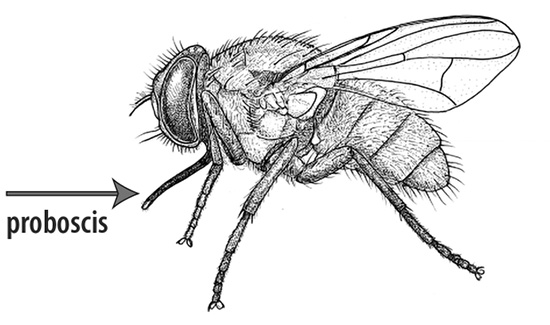
Horse Flies and Deer Flies
Horse flies are fairly large, heavy-bodied flies, with the larger species being about 1 inch long. Most deer flies are less than ½ inch long (Figure 3). Horse fly wings are clear or slightly tan, while deer fly wings are patterned with brown or black spots in them. Females are found on or around cattle only when they search for a blood meal. Males are nectar feeders. Depending on species, larvae are usually found buried in mud along the sides of streams, ponds, roadside ditches, salt marshes, or the overflow areas of rice fields. A few species may develop in pasture soils or in leaf litter under trees. We don’t know much about the life cycle of these flies, but in most cases, it appears there are one to three generations per year. Adults are long-lived flies and some will be present throughout the summer. These flies do not suck blood like mosquitoes but cut with their mouthparts to create a wound. As the blood flows from the wound, it is absorbed by a section of their mouthparts that is sponge-like. Horse and deer fly bites are highly irritating to the host animal. Because these flies are highly mobile and spend little time on the animal, it is very difficult, if not impossible, to control them.
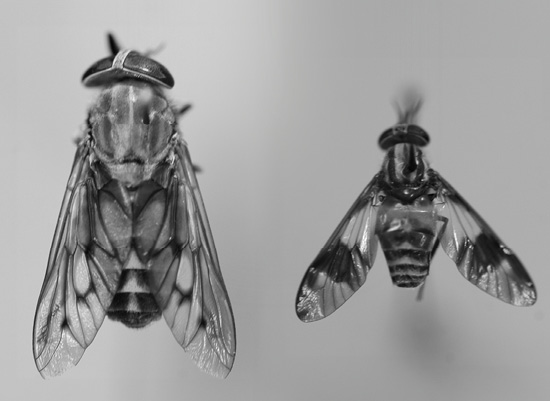
Sucking Lice
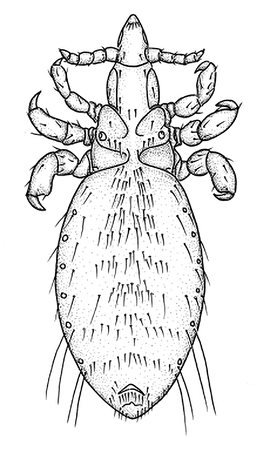
Lice infestations of cattle generally occur during winter, when the stress of the cold and the lice infestation can result in poor growth in replacement calves or reduced milk production in adult animals. However, lice might be present in very low numbers on animals during summer months. Reproduction increases as the weather cools in the fall, and by spring of the following year, lice numbers can be very high in uncontrolled situations. Lice in all life stages are found on the animal. Females attach their barrel-shaped eggs (nits) to the hair shafts, where they usually take 10 to 14 days to hatch. Nymphs begin to feed as soon as they hatch and continue to feed frequently. Infestations are usually found on the head, neck, and withers or along inner surfaces of the legs, although one species feeds at the base of the tail.
Heel Flies or Cattle Grubs
Heel flies are not as common as they were before the mid-1960s, but they still occur occasionally. Eggs are deposited on leg hairs of the host animal in the spring. The eggs hatch within 2 to 4 days, and the young larvae or cattle grubs bore into the body and migrate through the connective tissue of the host animal. The migratory process eventually ends with the formation of a warble on the back of the animal the following spring. Approximately halfway through this process, the grubs accumulate in the esophageal area and may remain in this area for 6 to 10 weeks. This timeframe may include parts of October, November, December, and early January. It is important to apply controls before they accumulate in the connective tissue of the esophagus. If large numbers are killed in the esophagus by using anthelmintics, byproducts of decay might compromise the health of the host animal; therefore, it is recommended that treatment take place before October 1.
Mange Mites
Two species of mange mites might occur on dairy animals, particularly animals in confined situations as either adults or calves. Chorioptic mange is probably the most common form of mange in cattle and small ruminants. You might see the first lesions in the tail area or legs and then in other parts of the body. Another mite, Sarcoptes, responsible for scabies infestations might also occur on dairy animals, but is less common than chorioptic mange. The first lesions are usually on the head and neck and spread from this area to other parts of the body. In the case of scabies, signs usually appear as encrusted areas with thickening of the skin, which then lead to small folds of skin on the neck. To relieve itching caused by mites, the animal rubs against objects and loses some hair as a result. Chorioptic mange causes the skin to appear scaly with a crust formation and a thickening of the skin. In some cases, the skin also appears moist. If you suspect a mite infestation of any kind, consult your veterinarian for diagnosis and treatment.
Arthropods Associated with the Dairy
Insects and other arthropods in this group do not feed on animals but are attracted to the area by manure, spilled feed, moisture, or harborage. A number of insects fall into this category, but house flies and cockroaches are the most problematic.
House Flies
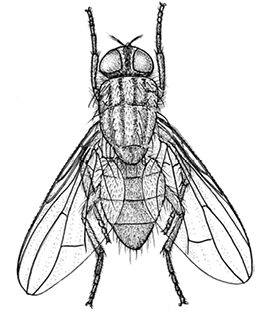
Adult house flies have sponging type mouthparts. They feed by regurgitating small amounts of digestive enzymes onto the surface of the food source and then sponging up the resulting predigested liquid. House flies feed on a wide variety of foods in various stages of decay. Animal excrement can serve as a food source or as a breeding site. These flies are prolific, and there can be 8 to 10 generations per year. Females deposit eggs on the surface of a wide range of decaying organic material, such as manure, fermenting feed, silage waste areas, lagoon overflow areas, decaying grass, or similar sites. Eggs usually hatch in less than a day under optimum conditions. After hatching, larvae feed for 3 to 7 days and then seek slightly dried areas for pupation. The pupal period lasts 3 to 4 days. Newly emerged adults feed and mate. Females lay eggs within 2 to 4 days after emerging from the pupal case. When not feeding, houseflies rest on barn walls, ceilings, stall supports, fences, light wires, or various plants.
Cockroaches
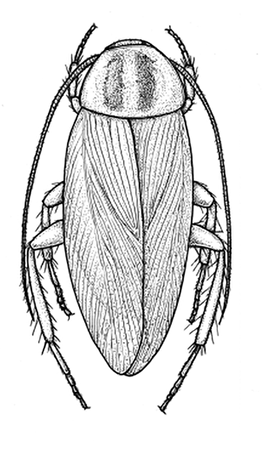
Although there are several different species of cockroaches, only three are considered pests at dairies in Mississippi: the American, smoky brown, and German cockroaches. American cockroaches are about 1½ inches long and are reddish brown. The smoky brown cockroach is 1 to 1¼ inches long and is dark brown to black. After mating, females develop egg cases that remain attached to their body for about 24 hours. Then, the egg case is indiscriminately dropped at some point or is glued to a surface. Egg cases contain 14 to 16 eggs for the American and 24 eggs for the smoky brown cockroach. Females of both species produce about 20 egg cases during warmer months of the year. The German cockroach (see illustration) is much smaller than the other two species, measuring only about ½ to 5/8 inch long as an adult. It is light brown with two dark stripes on the cap (pronotum) above the head. German cockroach females keep the egg case until the eggs are about to hatch. At this point, the egg case is attached to a surface in areas frequented by the female. Each female produces four to eight egg cases, with each case containing 30 to 48 eggs. In some situations, German cockroaches are found in natural settings, but mostly they are found in buildings. The American and smoky brown cockroaches can be found either outside or inside buildings. Once inside, the insects prefer warm, moist areas with an available food supply, often around pipes, hot water tanks, or sewage systems. Smoky brown cockroaches are often found in slightly drier areas than either the American or German cockroaches. Cockroaches forage for food at night and feed on a wide variety of foods, including animal excrement, milk, milk byproducts, dead insects, fresh or dried blood, or any food that could be used for human consumption. Depending on feeding sequence, these insects might serve as a mechanical vector by moving disease organisms from one food source to the next.
Spiders

These arthropods often live around dairy barns. Although spiders do not usually cause problems with livestock, their webbing could be perceived as unsanitary during inspections, and their webs collect dust and insect body parts, which can contaminate milk. However, you might also argue that spiders are a form of biological control since they feed on insects and flies. Two spiders that might be found around barns are the house spider (see illustration) and the long-bodied cellar spider. The house spider is small, only 3 to 5 millimeters long. As described in How to Know the Spiders, 3rd edition, by B. J. Kaston et al., “This extremely common spider is found most often in barns and houses where it makes its webs in the corners of rooms and in the angles of windows.” The cephalothorax (front part of the body) is yellowish-brown, while the abdomen is off-white to brown with distinctive gray striping. Long-bodied cellar spiders have extremely long abdomens when compared to the rest of the body. They are pale yellow except for a gray area behind the eyes. Females are about a centimeter long. These spiders spin large, irregular webs.
Mosquitoes
Mosquitoes belong to the same group of insects as the house, horn, stable, and horse flies (order Diptera), but their bodies are not as robust as these other flies. Female mosquitoes are blood feeders, and some feed primarily on birds, while others feed on many small or large mammals. Male mosquitoes are nectar feeders. Not only are mosquito bites irritating, but mosquitoes can also transmit a number of diseases. The main diseases mosquitoes carry in the United States are the encephalitic viruses. These viruses are found in different bird species and are carried from birds to other birds, humans, and horses by several species of Culex mosquitoes. Female mosquitoes lay their eggs on or over a body of standing water. Possible water sources are birdbaths, wading pools, pet-watering containers, aquatic gardens, used tires, improperly maintained swimming pools, runoff from sewage lagoons, runoff from silage pits, temporary pooled water in tractor ruts, and any other area that might hold water for 8 to 10 days. Eggs hatch in 24 to 48 hours, and larvae feed for 5 to 7 days before pupating. The pupal period lasts for about 2 days. After this, adult mosquitoes emerge, and females immediately seek a suitable host for a blood meal.
On-Animal Insect Control
Controls for on-animal arthropods are largely based on using insecticides or acaricides. Primarily, insecticides are used around dairy barns, and their usage depends on the active ingredient and how it is formulated. These materials might be used as pour-ons, sprays, backrubbers, dusts, ear tags, or feed additives. Tables 1a–e list some common materials you can use on lactating dairy animals at the dilutions specified. Permethrin is the primary insecticide in a high percentage of these materials, which might present a control problem. Widespread use of this material can lead to insecticide resistance in flies, especially horn flies and house flies. If the permethrin-based insecticides have been used extensively over the past several years and control seems to have declined, switch to a nonpyrethroid insecticide. Read the label carefully. Four nonpyrethroid materials are listed in Tables 1a to 1f: Co-Ral, Ravap (organophosphate insecticide), Elector (a fermentation product), and Eprinex. If there is a high degree of resistance in the fly population, switching to a nonpyrethroid insecticide might not help, but it is the only alternative presently available. Insect growth regulators might also help in cases of resistance if certain criteria are met. See the comments under Altosid.
The following tables include insecticides for use on lactating dairy cows as sprays, back rubbers, pour-ons, dusts, feed additives, and ear tags. Products listed include some of the common active ingredients, but these are provided only as examples. These tables include only a few of the products available to dairy farmers for arthropod control. Note: Insecticide registrations are constantly being changed, new ones approved, and others canceled. Always read and follow label directions.
|
Pest |
Product and Formulation |
Dilution |
Remarks |
|---|---|---|---|
|
Horn flies, lice |
Elector (spinosad 2.46%) |
10 oz/5 gal water |
Apply 1–2 qt of coarse spray per animal over the body not more often than every 7 days. Make spray applications after milking. Do not apply within 2 days of slaughter. Do not make more than five consecutive treatments. When treating for lice, make a second application 45–60 days later. |
|
Ravap E.C. (tetrachlorvinphos 23% and dichlorvos 5.3%) |
1 gal/200 gal water or 2 oz/3 gal water |
Direct spray to thoroughly cover animal with up to 1/2 gal finished spray. Sprays may be made either before milking (allow a 20-minute delay before milking, wash teats with an approved cleaning agent, and dry) or after milking. Applications made after milking avoid many problems. |
|
|
Gardstar E.C. (permethrin 40.0%) |
high-pressure spray: 30–118 ml/25 gal water low-pressure spray: (hand-pump sprayer) 118 ml/2.5 gal water |
Apply 1–2 qt of dilution as a coarse spray per animal. Apply 4–5 fl oz per animal by spraying along the midline from the face to the tail head. |
|
|
Permectrin II (permethrin 10%) |
8 oz/50 gal or 1 qt/200 gal |
Apply to cover the entire animal. Do not apply more often than every 2 weeks. If applied before milking, thoroughly wash udders before milking. |
|
|
Atroban E.C. (permethrin 11%) |
1 qt/100 gal water |
Apply 1 quart of diluted spray per animal. Repeat as necessary not more often than every 2 weeks. Spray lactating animals after milking. |
|
|
A number of trade names containing pyrethrin plus piperonyl butoxide or other synergists are available. Pyrethrin concentrations may vary from 0.03% to 0.10%, while the synergist concentration will vary from 0.5 to 1.0% |
no dilution |
Most products of this type come as ready-to-use materials and do not require any dilution. Be sure to read and follow the label concerning application techniques. |
|
Pest |
Product and Formulation |
Dilution |
Remarks |
|---|---|---|---|
|
Horn flies |
Co-Ral (coumaphos 11.6%) |
93/4 fl oz/1 gal of #2 fuel oil or #2 diesel fuel |
This is a restricted-use pesticide. Place the backrubber where animals travel regularly and saturate the fiber portion with the dilution. Place high enough so that lactating animals can’t straddle it. Apply additional dilution as needed. |
|
Ultra-Boss (permethrin 5% and piperonyl butoxide 5%) |
100 ml/gal of #2 diesel oil or mineral oil |
Recharge device as needed. |
|
|
Permectrin II (permethrin 10.0%) |
8 oz/gal mineral oil or nonirritating organic oil |
Recharge device as needed. |
|
|
Atroban (permethrin 11.0%) |
1 qt/20 gal diesel oil |
Daily forced use will improve control. Recharge as necessary. |
|
|
Ravap E.C (tetrachlorvinphos 23% and dichlorvos 5.3%) |
1 gal/25 gal of an approved backrubber-based oil |
Pour diluted solution into oil reservoir of mechanical rubbing device, or pour 1 gal per 20 linear feet of burlap or rope backrubbers. |
|
|
Permectrin II (permethrin 10%) |
64 ml/gal mineral oil |
Forced use will improve control. Recharge as necessary. |
|
|
Brute (permethrin 10%) |
48 ml/1 gal diesel or oil |
Forced use will improve control. Recharge as necessary. |
|
Pest |
Product and Formulation |
Dilution |
Remarks |
|---|---|---|---|
|
Horn flies, lice |
CyLence Pour-On Insecticide |
less than 400 lb: 4 ml 400–800 lb: 8 ml 800 lb and up: 12 ml |
This is a ready-to-use material. Apply it directly along the top of the back and top of the head. Do not treat more often than once every 3 weeks. For lice control, double the amounts in the previous box. Application rate is based on the body weight of the animal. |
|
Peremectrin CDS (permethrin 7.4% plus piperonyl butoxide 7.4%) |
moderate fly numbers: apply 1.5 ml/100 lb bodyweight |
This is a ready-to-use product. No dilution is required when used as a pour-on. Use only with an accurate measuring container or applicator. Application rate is based on the body weight of the animal. |
|
|
Brute Pour-On (peremethrin 10%) |
birth–199 lb: 2.5 ml 200–399 lb: 5 ml 400–599 lb: 7.5 ml 600–799 lb: 10 ml 800–899 lb: 12.5 ml 1000 lb and up: 15 ml |
Application rates are based on the body weight of the animal. Two container sizes are available (16 oz and 128 oz), and amounts per animal will vary between the two sizes. Treatment volumes given here are based on using a gallon container and application with a Brute applicator gun. Follow the label if using the 16-oz container. |
|
|
Ultra-Boss (permethrin 5% plus, piperonyl butoxide 5%) |
3 ml/100 lb body weight up to a maximum of 30 ml |
Pour along the back and down the face. For optimum lice control, use two applications at 14-day intervals. |
|
|
Elector (spinosad 2.46%) |
4 ml/110 lb body weight |
When used as a pour-on, use undiluted. Do not treat more often than every 14 days, and do not make more than five consecutive treatments. |
|
|
Horn flies, lice, and mange mites |
Eprinex (0.5% eprinomectin) |
1 ml/22 lb body weight |
This product is used to control gastrointestinal roundworms, as well as sucking and biting lice and chorioptic and sarcoptic mange mites. The product will give about 7-day control of horn flies. |
|
Pest |
Product and Formulation |
Dilution |
Remarks |
|---|---|---|---|
|
Horn flies and lice |
Python (zeta-cypermethrin 0.075% and piperonyl butoxide 0.15%) |
ready-to-use |
When used in dust bags, the bags should hang 4–6 inches below the back line of the cows. Forced use gives much better control. Do not use this product if you are using ear tags containing the same active ingredients. |
|
Pest |
Remarks |
|---|---|
|
Horn flies |
Altosid (methoprene is sold to custom feed blending companies and is available in complete feeds or in mineral mixes). The active ingredient is an insect growth regulator that is passed through the animal and is present in the manure. Concentrations in the manure interfere with the ability of the larvae to molt. For control, each animal must eat the specified amount of methoprene and then distribute it throughout the manure. Continue this treatment during fly season. Some newly emerged flies might move from nearby, untreated herds. These flies might drift onto your animals as they search for a host animal. |
Table 1f. Ear Tags
Remarks
A number of ear tags with different active ingredients are available for use on lactating dairy animals. Some of these are CyLence Ultra (beta-cyfluthrin 8%), Max-Con (cypermethrin 7%, chlorpyrifos 5%, and piperonyl butoxide 3.5%), and Python Magnum (zeta cypermethrin 10% and piperonyl butoxide 20%). Follow the manufacturer’s application guidelines and use directions.
Premise Insect Control
Pests such as house flies, cockroaches, and spiders are attracted to dairies because of available food, water, and shelter. Although chemical controls seem to be the best first line of defense against insect pests around the dairy, nonchemical methods such as sanitation and physical methods are the most important components of managing dairy-related pests. Time is an important element when operating a dairy, and some of these methods, especially sanitation, can be time consuming. But this is not a good reason to overlook these basic premises of pest control. Time spent getting rid of feeding and breeding sites means fewer flies and cockroaches, which makes chemical controls more successful if you need them.
Manure Management
There are a number of methods to remove manure from barns. You can wash it into lagoons (the most efficient method) using some type of automated system, or you can scrape it up and spread it onto pastures or stack it to spread later. As you wash, some manure may be caught on posts, building supports, in corners, or behind feeding bunkers or troughs. If you are using automated systems, you might have to do some touch-up to ensure complete removal. Spreading manure in a field as thinly as possible allows the manure to dry. The drying process makes it unattractive to flies as a feeding or breeding site. Keep stacked manure below 30 percent moisture if possible. The dryer the better because manure at or below 30 percent is not attractive as a breeding site for flies. Do not overlook manure in calf pens. Manure mixed with bedding can provide breeding areas for house flies and stable flies. During the fly breeding season, clean these areas as frequently as possible.
Removal of Sweet Feed
Dairy feeds often contain sweet materials such as molasses or brewer’s yeasts, and these are very attractive to flies and cockroaches. Small amounts that might accumulate under feeding areas or in corners can provide food for flies or cockroaches. Cleaning these areas periodically helps reduce available food materials. Silage that is spilled around silos or trench bunkers provides food sources for adult flies as well as a breeding site for them. Keeping spillage to a minimum and providing good drainage around trenches helps eliminate available feeding and breeding sites.
Exclusion
Preventing a pest from gaining access to an area is a reliable pest-control technique. This might not work well on a dairy farm, given the constant movement of cows and personnel in and out of barns and milking parlors. But it could prove useful in specific areas, such as milk rooms. Make sure doors and windows fit well, and if windows are open, make sure screens are in place and in good shape. Cockroaches often move along water pipes within wall voids and then out into room spaces where the pipes enter a room. Caulking pipe openings prevents roaches from moving into the room. You can also use caulking around window and door frames or where other service lines enter the room.
Insect Light Traps
A number of insects, including house flies, are attracted to ultraviolet (UV) light sources used in light traps (also called black light traps). Historically, traps were fitted with the lights and an electrical grid. To reach the light source, insects had to fly through the grid where they received an electrical shock. The electrocution process often caused smaller insects to explode, sending insect body parts into the surrounding air space. This led to contamination concerns, especially in food-processing areas. Traps today are still fitted with UV lights, but the electrical grids have been replaced with a glue board. This type of light trap is ideal for use in milk rooms. If possible, place traps 5 feet above the floor and do not allow them to be visible from the outside. Clean the trap monthly during fly season and replace the glue boards. Replace bulbs yearly, because UV bulbs lose their attractiveness to flies long before they burn out.
Baited Traps
Cockroaches are attracted to a number of food odors, so you can use highly volatile fermenting odors in traps for these insects. One example is a homemade jar trap you can use to survey an area for cockroach populations. Or if the area is small, you might use it as a control option. To use this method, take a quart- or gallon-sized jar and coat the inner surface of the jar neck with a film of petroleum jelly. Next, place a small piece of bread in the bottom of the jar and moisten it with 15 to 20 milliliters of beer, fermenting fruit juice, or a small piece of overripe banana. Place jars under sinks next to the wall, under or around bathroom fixtures, against walls, or around hot water tanks. Put the jars in place after cleanup at night and check the next morning. Destroy any trapped cockroaches.
Light Management
Spiders are attracted to dairy structures because of the presence of insects they eat. Insects other than flies and cockroaches are attracted to lighting that may be used around the structures at night. This may draw more spiders. If possible, reduce the amount of lighting used at night or use lighting that is less attractive to insects. Lighting that provides a yellow spectrum is less attractive than bright white or slightly blue light.
Physical Removal
Vacuuming has been used successfully for pest control and is a good option for removing spider webs and spiders from dairy facilities. One such backpack vacuum is called the “Lil Hummer” and is available for this purpose. Its airflow is 95 to 100 cubic feet per minute, and the static lift is 95 to 150 inches, depending on the model. The unit is fitted with a high efficiency particulate air (HEPA) filter, which greatly reduces the amount of particulate matter that reenters the air space. This can be an important asset in the milk room. With extra extensions, this vacuum can clean areas as high as 40 feet. Price may be a factor with this unit, but some of the wet/dry shop vacuums might work just as well. HEPA filters are also available for these. You can also use a vacuum to clean up feed that might have worked its way into hard-to-reach areas around the barn. Vacuuming periodically throughout the year is much better than a “crash cleaning” just before your annual inspection.
Water Management
The presence of water determines whether you will have mosquitoes on your dairy. Anything you can do to eliminate standing water helps reduce mosquitoes. For example, using old tires to hold down coverings on silage pits provides excellent mosquito-breeding sites. Drilling holes or making slits in the tires allows collected water to drain, which prevents the area from serving as a mosquito breeding ground. If mosquitoes are problems in and around the barn, you can use sprays to control houseflies and adult mosquitoes.
Insecticide Applications
After cleanup, apply insecticide to various surfaces if needed. It is much easier for insects and spiders to absorb a residual dose of insecticide from a clean surface than from one covered with dust or oily film.
When applying insecticides in the milking facility, treat each area uniquely. The facility might contain a number of different areas, including a congregating area for cows before milking, the milking parlor, the milk room, and possibly a post-milking feeding area. Before milking, the cows congregate in an area next to the milking parlor, and the accumulation of manure in this area might contribute to house fly populations in other sections. Prompt removal of manure from this area helps reduce house fly numbers. After cleaning, apply residual insecticides to fly resting surfaces in this area. From the congregating area, the cows move into the milking parlor. Once the milkers are attached, the milk is in a contained system and is not exposed to outside contamination sources. Two EPA-registered residual sprays list “milking parlor” on the label, and these materials are shown in Tables 2a–c. When using residual insecticides in this area, make sure teat cups, other milking equipment, and feeding stations are not contaminated with residual sprays. The milk room is considered a food-processing area, and available products are limited. Rely on sanitation as well as physical methods as primary means of pest control in this area. You can use short residual materials such as pyrethrins plus a synergist in this area. At least one residual product, Tempo SC, has an EPA registration for food-processing areas plus dairies on the label. If it becomes necessary to use any insecticide in the milk room, make sure that cooling equipment and bulk tanks are protected from possible contamination.
The following tables include suggested insecticide baits, sprays, and aerosols for use as premise sprays around dairy operations. Not all products are cleared for these areas. Make sure the products you are using specifically state you can use them in milking parlors and milk rooms.
|
Pest |
Product and Formulation |
Dilution |
Remarks |
|---|---|---|---|
|
House flies |
QuikStrike (nithiazine 1%) |
none required |
This strip is a sugar-based feeding matrix that is attractive to house flies. You can put it in dairy barns or milking parlors. Placing the strip 4–5 feet from the floor or ground is ideal for attracting flies, but this may not be practical. |
|
Starbar Quikstrike Fly Bait (dinotefuran 0.50% and (Z)-9-Tricosene 0.04%) |
none required |
Fly bait that attracts and kills house flies in industrial, commercial, and agricultural sites. It is ready to use by scattering or in fly bait stations. May be used around the outside of milking parlors. |
|
|
Quick Bayt (imidacloprid 0.50%) |
See remarks for dilution as a paint-on. |
May be used as a scatter bait application, in bait stations (use 1 station per 250 sq ft), or as a paint-on. As a paint-on, dilute 3 lb/1 qt of warm water and stir thoroughly. Let stand for about 15 minutes, until it is a pasty consistency. Paint areas where flies rest. This bait is for use in dairy barns or milking parlors. |
|
Pest |
Product and Formulation |
Dilution |
Remarks |
|---|---|---|---|
|
Flies (also helps control cockroaches/spiders) |
Permectrin II (permethrin 10%) |
as a spray: 8 oz/6.25 gal water |
Spray surfaces to runoff with dilution using 1 gal/750 sq ft. Fog 4 oz/1000 sq ft. |
|
Atroban (permethrin 11%) |
1 qt/20 gal water |
Spray to the point of runoff. Do not apply to vinyl or plastic surfaces. |
|
|
Ravap E.C. (tetrachlorvinphos 23% and dichlorvos 5.3%) |
1 gal/25 gal water |
Apply 1 gal of dilution/500–1000 sq ft. |
|
|
Rabon (tetrachlorvinphos 50%) |
2 lb/6 gal water |
This dilution gives a 2% dilution, and you can use it on dry, whitewashed wood or concrete block surfaces. Use 1 gal of dilution/500 sq ft. |
|
|
Cockroaches (provides good control if applied correctly) |
Tempo SC (beta-cyfluthrin 11.8%) |
8 ml/some volume (volume depends on the surface being treated) |
Surface type dictates the volume needed per 1000 sq ft. For example, stainless steel/ceramic tile (glazed) requires the 8 ml to be mixed in 0.2 gal (25.6 oz) of water. Unpainted plywood requires the 8 ml to be mixed in 2.7 gal of water and applied to 1000 sq ft of surface area. Consult label for additional surface types. |
|
Flies |
Elector (spinosad 2.46%) |
20 oz/5 gal water |
Use 1 gal of dilution per 500–1000 sq ft. Spray to the point of runoff. |
|
Pest |
Product and Formulation |
Remarks |
|---|---|---|
|
House flies and cockroaches |
CV-80 (pyrethrin 0.5% plus piperonyl butoxide 4%) |
This is a ready-to-use aerosol. Cover milk and equipment to prevent contamination by the spray or falling insects. To apply, close windows and doors and direct spray upward. Discharge spray for 2–3 seconds per 1000 cubic feet of room space. Leave room after application, and ventilate before using the area. |
|
Clear Zone (pyrethrin 0.5% plus piperonyl butoxide 4%) |
This is a ready-to-use aerosol. Cover milk and equipment to prevent contamination by the spray or falling insects. To apply, close windows and doors and direct spray upward and in all directions. Discharge spray for 1–3 seconds per 1000 cubic feet of room space. Keep room closed for 15 minutes following treatment, and ventilate before using the facility. |
1 The listed products should be used around dairy barns and loafing areas. Do not contaminate food or water sources or milking equipment. The sprays should not be used in the milking parlor or milk room. Do not apply the following product concentrations directly to animals.
2 A number of other trade names containing pyrethrin plus piperonyl butoxide are available for use as described above in milk rooms. The names listed are only examples.
The information given here is for educational purposes only. References to commercial products, trade names, or suppliers are made with the understanding that no endorsement is implied and that no discrimination against other products or suppliers is intended.
Publication 2357 (POD-05-24)
Revised by Jerome Goddard, PhD, Extension Professor, Biochemistry, Molecular Biology, Entomology, and Plant Pathology; and Kristine T. Edwards, PhD, Senior Extension Associate (retired), Biochemistry, Molecular Biology, Entomology, and Plant Pathology.
The Mississippi State University Extension Service is working to ensure all web content is accessible to all users. If you need assistance accessing any of our content, please email the webteam or call 662-325-2262.



